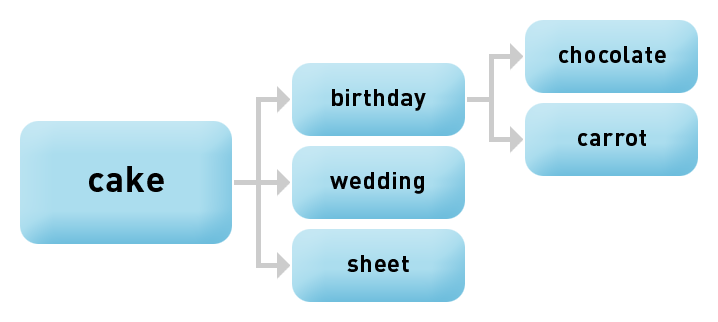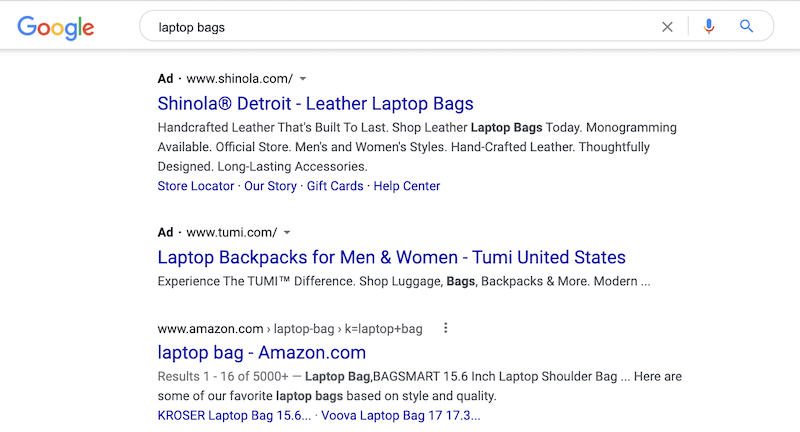
Keywords: What Are Keywords & Why Do They Matter for PPC?
In pay-per-click marketing, everything starts with a keyword.
When you use Google or any other search engine, you type words into the search box to find what you’re looking for. The results that Google returns – whether they’re organic results or paid advertisements – are there because they’re relevant to the words in the search box. And if you want your ads to show up on the page, you have to bid on that keyword.
Therefore, to succeed at PPC, you need to make sure you’re bidding on the right keywords. This process includes a few moving parts:
- PPC Keyword Research – Using keyword research tools and analytics data to find a list of keywords that are highly relevant to your business offerings. The goal is to show up in the search results when people search for products or services that are relevant to your business.
- Keyword Grouping and Organization – The most effective PPC accounts organize keywords into small groups of tightly related keywords.
- Negative Keywords – Negative keywords are a way of filtering out unwanted clicks. By setting a new negative keyword, you tell Google what searches you don’t want your ads to display for.
- Keyword Bid Optimization – Everyone has a limited budget, so it’s important to focus your spending on your best-performing keywords, without paying more than necessary.
🔎 Need help finding the right keywords? Try our Free Keyword Tool!
As you can see, PPC isn’t just a matter of finding the right keywords. In order to get high ad rankings at low costs, you’ll need to work at achieving relevance across your account. That means having:
- An organized account structure
- Targeted, compelling ads, and
- Optimized landing pages
All of these factors will contribute to your keyword Quality Score – the key metric that determines where your ads are displayed and how much you pay for each ad click.
You can learn more about all of these concepts later on in the coursework. For now, let’s focus on keywords and how they function in your PPC account.
Keywords vs. Search Queries
In casual conversation, the terms “keyword” and “search query” are often used interchangeably, but there is actually a difference. What is the difference between a keyword and a search query?
A keyword is an abstraction that we extrapolate from multiple search queries.
A search query is the actual word or string of words that a search engine user types into the search box.
As search marketers, what we target are keywords. For example, one of your target keywords might be “sunglasses.” When you bid on the keyword sunglasses, the search queries that trigger your ad might include variations like “women’s sunglasses,” “aviator sunglasses,” or “sunglasses for small faces.” These search queries all map back to your primary keyword.
The Importance of Keyword Grouping
Because search queries have so much variance, account structure best practices dictate that PPC marketers group their keywords into related clusters.
Effectively grouping and organizing your keywords improves your PPC strategy by enabling you to create more relevant, Quality Score-friendly ad groups, text ads and landing pages.
The easiest way to get started is to use a keyword tool to break a large list of keywords down into smaller groups by theme. You can then break those groups into even smaller groups, forming a hierarchy, or tree structure:
This structure will map to your Google Ads campaigns and the ad groups within those campaigns.
How Keywords Work in Your PPC Ads
Your text ads need to be relevant to the keywords you’re bidding on in order to earn high Quality Scores, which determine where your ad appears and your cost per click (CPC).
The keyword you’re bidding on should actually appear in your ad in order to show relevance to both Google and the searcher. The term the user searches on will appear in bold in the ad descriptions, so using the keyword more than once will really make your ad “light up”:
Some tips for using keywords in your PPC ads:
- Try to use the keyword in the headline and once more in the description lines, if you can do so while still communicating benefits and including a call to action.
- Bid on long-tail keywords, which have less competition and are therefore more targeted and less costly.
- Consider dynamic keyword insertion, which inserts the searcher’s exact search query into your ad, making it extra-relevant to them.
- Use sitelinks to expand your ad and include more related keywords.
🛑 Want to learn more about search engine marketing on Google? Get the free guide >> PPC 101: Complete Guide to Google Ads
Keyword Match Types
When you bid on keywords, you have the option of telling Google how restrictive it should be when matching your ads against relevant search queries. There are four keyword match types, from least restrictive to most restrictive:
- Broad match – This is the default keyword match type. Google will match your ad against the greatest number of possible queries. For example, if you bid on the keyword “massage,” your ads might show when people search on longer phrases that include “massage,” like “Miami massage” or “deep tissue massage therapist.” Your ads might also show for closely related searches like “hot stone therapy.”
- Phrase match – This match type allows you to tell Google to display your ad only when the search query includes a full phrase, such as “hot stone.” (The words have to appear in that order.) Other words may be included in the search query before or after the phrase. As of February 2021, the phrase match keyword type has been expanded to match more queries, as the broad match modified keyword type gets retired and absorbed into phrase match).
- Exact match – The most restrictive match type, exact match tells Google to only match your ads to queries that are exactly the same, word for word, as your keyword.
Broad match keywords have the advantage of allowing the maximum number of impressions and clicks – however, those clicks are less targeted and may be less likely to convert. The more restrictive the match type, the fewer clicks you’ll receive, but that traffic will be more relevant and more qualified.
Keyword Resources to Help You Along the Way
WordStream offers a Free Keyword Tool that makes it fast and easy to find the keywords your business needs to drive traffic through organic and paid search. If you want to better organize those keywords into actionable segments, check out our learning resources on keyword niches and keyword grouping.

